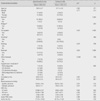Abstract
Purpose
To investigate the effectiveness of aromatherapy on blood pressure, heart rate variability, aortic pulse wave velocity and the aortic augmentation index of essential hypertensive patients.
Methods
Using a coin toss, 22 participants were assigned to the experimental group and 20 to the control. The experimental group was given a blend of oils of lemon (Citrus limonum), lavender (Lavandula angustifolia), and ylang ylang (Cananga odorata) which were prepared in the ratio of 2:2:1, respectively. The control group was given an artificial lemon fragrance of Limonene (35 cc) and Citral (15 cc) mixture. The experiment, inhalation, was conducted for 3 weeks (2 min per inhalation, 2 times per day) to both groups.
Results
There was a noticeable difference in systolic blood pressure between the groups (p=.001), however the difference in diastolic blood pressure between the two groups was not significant. There was a notable difference in sympathetic nerve system activity of heart rate variability (p=.047). However, the differences in aortic pulse wave velocity or the aortic augmentation index were not significant.
Figures and Tables
Table 1
Homogeneity Test for Characteristics and Research Variables between Groups

*Fisher's exact test.
BMI=body mass index; RAS antagonists=renin angiotensin system antagonists; CC blockers=Ca channel blockers; HRV=heart rate variability; PWV=pulse wave velocity; AIx=augmentation index.
Etc.: RAS antagonists+β-blocker, RAS antagonists+diuretics, β-blocker+CC blockers, diuretics, RAS antagonists+CC blockers+diuretics; LF norm: sympathetic nerve system activity; HF norm: parasympathetic nerve system activity.
References
1. Battaglia S. The complete guide to aromatherapy. 1995. Brisbane: The Perfect Potion (Aust) Pty Ltd.
2. Blacher J, Asmar R, Djane S, London GM, Safar ME. Aortic pulse wave velocity as a marker of cardiovascular risk in hypertensive patients. Hypertension. 1999. 33:1111–1117.
3. Bodlaj G, Berg J, Biesenbach G. Diurnal variation of pulse wave velocity assessed non-invasive by applanation tonometry in young healthy men. Yonsei Medical Journal. 2007. 48:665–670.
4. Buckle J. Clinical aromatherapy: Essential oil in practice. 2003. 2nd ed. Churchill Livingstone: Elsevier Science.
5. Cha JH. Effects of aromatherapy on headache, anxiety and serum cortisol level in the middle-aged women. 2005. Seoul: The Catholic University;Unpublished doctoral dissertation.
6. Chern CM, Hsu HY, Hu HH, Chen YY, Hsu LC, Chao AC. Effects of atenolol and lasartan on baroreflex sensitivity and heart rate variability in uncomplicated essential hypertension. Journal of Cardiovascular Pharmacology. 2006. 47:169–174.
7. Cohen J. Statistical power analysis for the behavioral sciences. 1988. 2nd ed. Hillsdale, NJ: Lawrence Erlbaum Associates.
8. Edge J. A pilot study addressing the effect of aromatherapy massage on mood, anxiety and relaxation in adult mental health. Complementary Therapies in Nursing & Midwifery. 2003. 9:90–97.
9. Fei L, Copie X, Malik M, Camm J. Short and long term assessment of heart rate variability for risk stratification after acute myocardial infarction. The American Journal of Cardiology. 1996. 77:681–684.
10. Willum-Hansen T, Sraessen JA, Torp-Pedersen C, Rasmussen S, Thijs L, Ibsen H, et al. Prognostic value of aortic pulse wave velocity as index of arterial stiffness in the general population. Circulation. 2006. 113:664–670.
11. Hwang JH. The effects of the inhalation method using essential oils on blood pressure and stress responses of clients with essential hypertension. Journal of Korean Academy of Nursing. 2006. 36:1123–1134.
12. Jolanta B. The effects of aromatherapy treatment on raised arterial blood pressure-pilot study. Positive Health News. 1999. 39:20–23.
13. Jung AD, Kim W, Park SH, Park JS, Cho SC, Hong SB, et al. The effect of telmisartan on endothelial function and arterial stiffness in patients with essential hypertension. Korean Circulation Journal. 2009. 39:180–184.
14. Jung YJ. Effects of aromatherapy on blood pressure, heart rate variability, and serum catecholamines in the pre-hypertension middle aged women. 2007. Seoul: The Catholic University;Unpublished doctoral dissertation.
15. Lee JW. Pulse pressure and systolic blood pressure. Korean Circulation Journal. 2002. 32:293–298.
16. Lee SH, Shin JH, Kang EY, Lee YJ, Jung SY, Yoo KD, et al. The clinical significance of aortic pulse wave velocity in Korean adults. Journal of the Korean Academy of Family Medicine. 2006. 27:782–788.
17. Lee SM. A study of hemodynamic change through non-invasive plethysonogram analysis for hypertension patient treatment. 2003. Seoul: Yonsei University;Unpublished doctoral dissertation.
18. Ministy of Health & Welfare. Yearbook of MOHW statistics. 2010. Seoul:
19. Nichols WW. Clinical measurement of arterial stiffness obtained from noninvasive pressure waveforms. American Journal of Hypertension. 2005. 18:3S–10S.
20. Oh HK. Aromatherapy. 2000. Seoul: Yangmoon Publishing Company.
21. Okada M, Matsuto T, Satoh S, Igarashi S, Baba M, Sugita O, et al. Role of pulse velocity for assessing autonomic nervous system activities in reference to heart rate variability. Medical Informatics. 1996. 21:81–90.
22. Park CW, Kim KS, Lee YS, Nam CW, Lee SH, Han SW, et al. Acute effects of caffeine on arterial stiffness in young healthy subjects. Korean Circulation Journal. 2005. 35:841–846.
23. Pumprla J, Howorka K, Groves D, Chester M, Nolan J. Functional assessment of heart rate variability: Physiological basis and practical applications. International Journal of Cardiology. 2002. 84:1–14.
24. Seo SK. The relationship between hypertension and stress measured by heart rate variability in a rural area. 2007. Seoul: Hanyang University;Unpublished doctoral dissertation.
25. Shin YS, Cho YS, Jung YJ. The effects of aromatherapy on autonomic nerve system and physical resistance of a stress. Journal of Korean Biological Nursing Science. 2004. 6:5–17.
26. Youn JC. Influence of arterial stiffness on seasonal variation
of blood pressure in hypertensive patients. 2006. Seoul: Yonsei University;Unpublished master's thesis.
27. Zia E, Hedblad B, Pessah-Rasmussen H, Berglund G, Janzon L, Engström G. Blood pressure in relation to the incidence of cerebral infarction and intracerebral hemorrhage. Hypertensive hemorrhage: debated nomenclature is still relevant. Stroke. 2007. 38:2681–2685.




 PDF
PDF ePub
ePub Citation
Citation Print
Print




 XML Download
XML Download